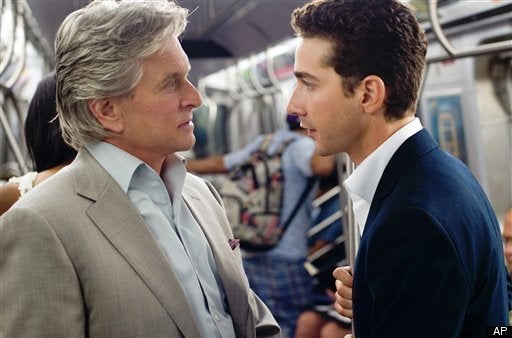
Halfway through Wall Street: Money Never Sleeps, a little old lady asks Michael Douglas's Gordon Gekko to define "moral hazard." I leaned forward. By this point in the movie, I was ready for a slogan that would capture 2008 the way the original Wall Street's "Greed is Good" pinned down the 1980s. But all Gekko can muster is an unenlightening "It means they can steal your money and no one is responsible." Like most of the rest of the film, it was a missed opportunity to shed light on the worst financial crisis since the 1930s. The crash of 2008 deserves a defining film. This isn't it.
Stone's original Wall Street, made in 1987, was less about specific events than the atmosphere at the time, but his sequel weaves in history so raw it still hurts: Lehman Brothers' collapse, the Goldman Sachs' bailout and the creation of TARP all appear, thinly disguised. In that sense, Money Never Sleeps resembles Stone's other contemporary histories: Nixon, W. and JFK. The disaster of 2008 seems tailor made for a lefty like Stone: to indict capitalism, all you have to do is tell the story. And yet in Stone's version, the near-collapse of the world financial system comes across less as the mass delusion and systemic failure it was than as a Wall Street vendetta that got a little out of hand.
Shia LaBoeuf plays Jacob Moore, an idealistic investment banker with Keller Zabel, a fictional mashup of Bear Stearns and Lehman Brothers. When rumors that the firm is insolvent drive Keller Zabel out of business, Moore blames the bank's slick rival, Churchill Schwartz (a stand-in for Goldman Sachs), and vows revenge. His ally in this quest is Gordon Gekko, who has just finished the prison term he was headed for at the end of Wall Street. In return for his help, Gekko wants Moore's aid in reconciling with his daughter, who just happens to be Moore's fiancée. Got that?
All this plays out against a backdrop of the real 2008 crisis. Archived clips from CNBC and CNN tracking the collapse of the economy alternate with fictional reports (with the same anchors) on the fate of Keller Zabel and Churchill Schwartz. Real Wall Street figures make cameos, including Nouriel Roubini, an economist who saw the recession coming, and Jim Chanos, a hedge fund manager best known for having predicted the collapse of Enron. (Both were advisers to Stone on the film.) A couple crucial scenes take place at the Federal Reserve Bank of New York, the building where the fate of Lehman Brothers, Bear Stearns and TARP were really decided. For kicks, the actor who plays the Secretary of the Treasury in these scenes is a dead ringer for Hank Paulson.
For casual moviegoers, these touches might increase the film's verisimilitude (or, depending on your point of view, blur the distinction between movie and reality). But for anyone who hoped that the film might convey some understanding of the crisis, they only heighten the disappointment.
The financial crisis was not, of course, a simple case of insanely greedy bad guys stealing from idealistic good guys. It was a matter of normal people following a chain of corrupt incentives to their logical conclusion. You know the story: Cheap money and a misguided faith in home prices created a real estate bubble. The boom, in turn, created an incentive for people to buy houses they couldn't afford with loans they couldn't repay and for banks to lend them the money anyway. Securitization gave Wall Street the means to mint money from those reckless mortgages and a reason to encourage banks to lend ever more foolishly-along with a false confidence that if things went sour, no one would be left holding the bag. Malevolent bankers were the pushers, but all America was addicted.
Stone has his chances to tell this story but mostly blows them. For example, an early draft of the Money Never Sleeps script, leaked on DocShare.com, includes a reasonably coherent lecture by Gekko on the wide-ranging origin of the crisis. In the film, the lecture is reduced to a disjointed series of punch lines-perhaps a conscious effort to create another "greed is good." Later, Gekko lectures Moore on the tulip bulb mania in 17 century Holland, but he never makes the connection to, say, 21 century Orange County or Las Vegas. Like the little old lady asking about "moral hazard," the audience gets a one-liner or two to swap over drinks after the movie, but no understanding of what just happened to their life's savings.
Recent history aside, Money Never Sleeps is a decent relationship film about a father and daughter reunion and a mediocre "sting" flick about a hero exacting revenge for a friend's disgrace. It has some gorgeous helicopter images of office towers in Manhattan and Jersey City. But context matters when you're talking about current events; and as a chronicle of the crisis, the film is not much use. To understand what really happened to your money, read Michael Lewis's The Big Short or listen to National Public Radio's The Giant Pool of Money. You'll be just as entertained as you would be by Wall Street: Money Never Sleeps. Plus, you'll learn something.
This post first appeared on The Fiscal Times
Eric Schurenberg is Editor-in-Chief of CBS MoneyWatch.com